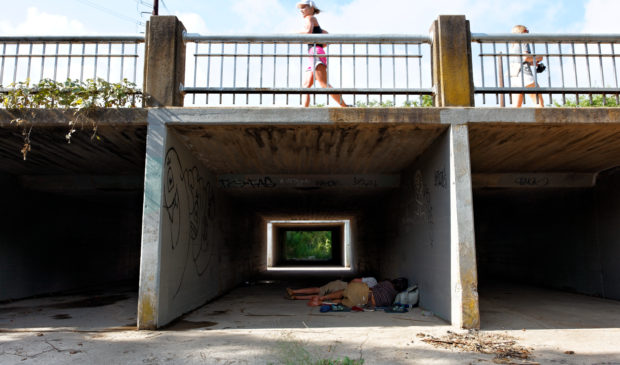Big-picture look at homelessness downtown shows challenges ahead
Friday, May 21, 2021 by
Amy Smith A cross-section of representatives briefed the Downtown Commission on Wednesday about an ambitious suite of strategies underway to house unsheltered individuals in Austin.
Their message was clear: The city and its partners are doing an enormous amount of work toward providing housing and other services to people experiencing homelessness. The response from some commissioners was equally clear: Plenty of people are still dismayed that City Council lifted the camping ban two years ago without having a plan in place, a factor that contributed to voter approval of Prop B, which effectively reinstated the camping ban on May 11.
Clearly, the finer machinations of politics and government do not always operate in tandem. It’s safe to say that the age-old tensions between Council and staff members – and perhaps among Council members themselves – also contributed to the inelegant handling of the homelessness crises.
Chair August Harris and Commissioner Joel Sher aired their frustrations with Council’s action and city management’s performance. “I think everybody that is working on this so diligently is making great progress,” Harris said after the briefing. “I think it was an utter failure of city management that we are where we are now because (Council) passed the ordinance without a plan.”
Dianna Grey, the city’s homeless strategy officer since January, said while the city has, in fact, invested an enormous amount of time and money into this effort, “perhaps (the city) could have been doing a better job of articulating the goals, the progress, and what the timeline was going to look like.”
Grey outlined what’s been done and work in the pipeline, including increasing the availability of permanent supportive housing for those with the greatest needs, acquiring two hotels with another two pending, and more recently, identifying potential sites for sanctioned encampments as part of a Council-approved resolution.
Matt Mollica, executive director of the nonprofit ECHO, told commissioners his organization is releasing today an updated estimate of the number of people experiencing homelessness in Austin, a number that is expected to run higher than the last point-in-time count of 2,506 in 2020.
The pandemic and other factors have created some notable trends, Mollica said. “We see massive disproportionality in people living with a disabling condition in our community of those experiencing homelessness. We see that 8 percent of the total population of Travis County report having a disabling condition, while 69 percent of people experiencing homelessness report living with a disabling condition.” Many among this segment are unable to work, and those who do face serious housing challenges.
Additionally, Austin’s housing costs and low wages come at a price. “Over the last year, Austin and Travis County have seen 50 percent of people that make 30 percent or less of the average median income lose their jobs, which is a much higher number than surrounding Texas cities,” Mollica said. “We’re seeing that the economic impacts of the pandemic are massive and it could result tragically in many more people losing their housing and ending up on the street.”
Mollica urged a more holistic look at how people fall into homelessness while keeping an eye on prevention. “We will be really strapped to support those folks if they’re not supported prior to experiencing homelessness,” he said.
Bill Brice, vice president of investor relations with the Downtown Austin Alliance, briefed the commission on the organization’s legwork and initiatives within the Downtown Public Improvement District, bordered east and west by Interstate 35 to San Antonio Street, and north and south by Martin Luther King Jr. Boulevard and Lady Bird Lake, and properties just south of the lake.
Working with its partners, DAA has initiated a monthly point-in-time count within the public improvement district, with April’s count showing roughly 742 individuals living in tents, in vehicles or completely unsheltered.
This week, the group launched a Healthcare for the Homeless program to provide housing-focused behavioral health care to 100-150 people a year, in partnership with Integral Care and Downtown Austin Community Court.
Commander Jeff Greenwalt and Lt. Lee Davis from the Austin Police Department provided a rundown of four phases they’re employing to obtain compliance with the camping ban. APD district reps have started an educational outreach effort that “preserves human dignity and respect.” In mid-June, they’ll begin issuing verbal warnings, then written warnings. Citations will be issued in July and early August, followed by the start of arrests and diversions.
“We’re hopeful that we get voluntary compliance (but) obviously the big elephant in the room is, where do we tell them to go?”
Commissioner David Gomez questioned how APD will be able to move through each phase if there is no direction on where homeless people should go.
“We have to tell them the truth, quite frankly,” Davis said, adding that APD is incorporating a fair amount of flexibility into its compliance process and working with the city’s partners for guidance.
Photo by Lars Plougmann made available through a Creative Commons license.
The Austin Monitor’s work is made possible by donations from the community. Though our reporting covers donors from time to time, we are careful to keep business and editorial efforts separate while maintaining transparency. A complete list of donors is available here, and our code of ethics is explained here.
You're a community leader
And we’re honored you look to us for serious, in-depth news. You know a strong community needs local and dedicated watchdog reporting. We’re here for you and that won’t change. Now will you take the powerful next step and support our nonprofit news organization?











